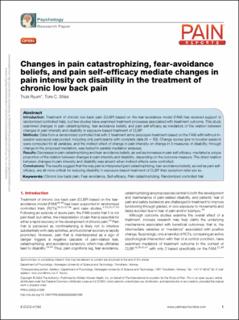| dc.contributor.author | Ryum, Truls | |
| dc.contributor.author | Stiles, Tore Charles | |
| dc.date.accessioned | 2024-02-01T10:23:28Z | |
| dc.date.available | 2024-02-01T10:23:28Z | |
| dc.date.created | 2023-10-18T12:11:04Z | |
| dc.date.issued | 2023 | |
| dc.identifier.citation | Pain Reports. 2023, 8 (5), . | en_US |
| dc.identifier.issn | 2471-2531 | |
| dc.identifier.uri | https://hdl.handle.net/11250/3115026 | |
| dc.description.abstract | Treatment of chronic low back pain (CLBP) based on the fear-avoidance model (FAM) has received support in randomized controlled trials, but few studies have examined treatment processes associated with treatment outcome. This study examined changes in pain catastrophizing, fear-avoidance beliefs, and pain self-efficacy as mediators of the relation between changes in pain intensity and disability in exposure-based treatment of CLBP. | en_US |
| dc.language.iso | eng | en_US |
| dc.publisher | Lippincott, Williams & Wilkins | en_US |
| dc.rights | Navngivelse 4.0 Internasjonal | * |
| dc.rights.uri | http://creativecommons.org/licenses/by/4.0/deed.no | * |
| dc.title | Changes in pain catastrophizing, fear-avoidance beliefs, and pain self-efficacy mediate changes in pain intensity on disability in the treatment of chronic low back pain | en_US |
| dc.title.alternative | Changes in pain catastrophizing, fear-avoidance beliefs, and pain self-efficacy mediate changes in pain intensity on disability in the treatment of chronic low back pain | en_US |
| dc.type | Journal article | en_US |
| dc.type | Peer reviewed | en_US |
| dc.description.version | publishedVersion | en_US |
| dc.source.pagenumber | 7 | en_US |
| dc.source.volume | 8 | en_US |
| dc.source.journal | Pain Reports | en_US |
| dc.source.issue | 5 | en_US |
| dc.identifier.doi | 10.1097/PR9.0000000000001092 | |
| dc.identifier.cristin | 2185860 | |
| cristin.ispublished | true | |
| cristin.fulltext | original | |
| cristin.qualitycode | 1 | |

